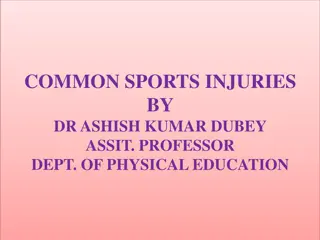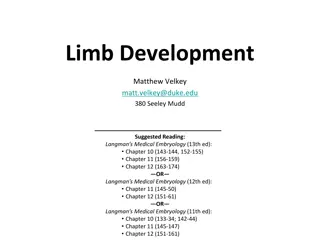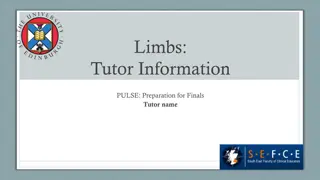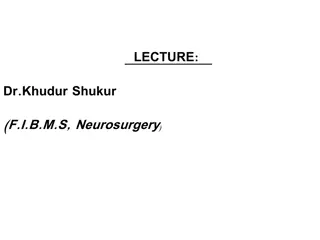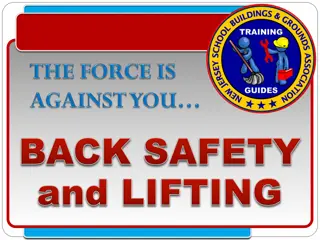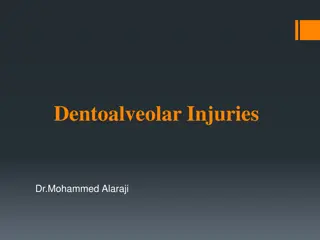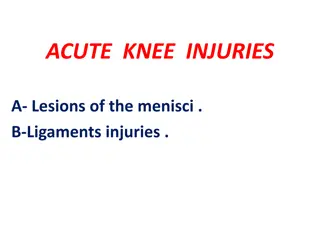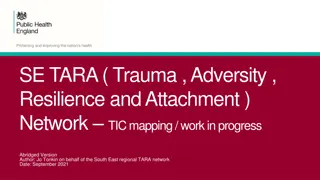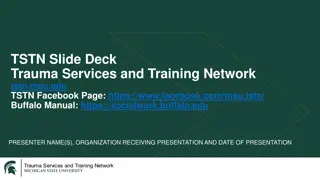Lower Limb Trauma: Injuries and Management Overview
This collection of images and descriptions covers common lower limb injuries, such as neck of femur, femoral fractures, and knee injuries. It provides insights into the assessment, treatment, and potential complications associated with lower limb trauma, emphasizing the importance of prompt evaluation and appropriate management.
Download Presentation

Please find below an Image/Link to download the presentation.
The content on the website is provided AS IS for your information and personal use only. It may not be sold, licensed, or shared on other websites without obtaining consent from the author. Download presentation by click this link. If you encounter any issues during the download, it is possible that the publisher has removed the file from their server.
E N D
Presentation Transcript
Lower Limb Injuries February 2019
Lower Limb Trauma Secondary survey? Hip to Toes Bones / Soft tissues Open / Closed injuries Local / distal Early / Late
Lower Limb Trauma Look Feel Move Neurovascular Other occult injuries? Treatment ?Pathological (# or cause)
Lower Limb Trauma Common / important lower limb injuries: NOF # Femoral # Knee Tibial plateau Fibula head Tibia Ankle Foot
Lower Limb Trauma Common / important lower limb injuries: NOF # Femoral # Knee Tibial plateau Fibula head Tibia Ankle Foot Look Feel Move Neurovascular Other occult injuries? Treatment ?Pathological
Lower Limb Trauma Common / important lower limb injuries: NOF # Femoral # Knee Tibial plateau Fibula head Tibia Ankle Foot Pitfalls! Look Feel Move Neurovascular Other occult injuries? Treatment ?Pathological
Neck of Femur Typically due to a fall in the elderly. Leg deformity? Other signs? Blood supply Delayed presentation (impaction)
Neck Of Femur Fast track orthopaedics Bloods, analgesia, ivi, ECG Block Remember why have they fallen?
Femoral Fracture Typically due to significant trauma in young. Signs Tender, palpable bone, abnormal movements. Other injuries mechanism.
Femoral Fracture ABC iv access, fluids, bloods (inc. x-match) Analgesia Thomas splint Orthopaedics
Fat Embolus Suspect the unexpected Long bone fractures - and others Looks like a PE CxR changes
Knee Injuries Fractures / dislocation Ligamentous injuries Cartilage injuries
Knee Injuries Swelling / effusion, bruising, deformity Tenderness Full ROM? SLR? Abnormal movements / ligamentous injury Neurovascular Investigation
Ottowa Knee Rules XRAY Only required if: Age 55 or over Isolated tenderness of the patella (no bone tenderness of the knee other than the patella) Tenderness at the head of the fibula Inability to flex to 90 degrees Inability to weight bear both immediately and in the department (4 steps - unable to transfer weight twice onto each lower limb regardless of limping).
Patella # Analgesia, immobilisation. May need ORIF (esp transverse fractures) Bipartite patella
Tibial Plateau # Analgesia Long leg backslab Orthopaedics
Patella dislocation Reduce under analgesia e.g. entonox Use thumbs to lever patella back into place Cylinder POP / cricket pad splint Quads exercises Fracture clinic
Ligament injuries ACL prevents tibia sliding forward relative to femur. +ve anterior draw PCL prevents tibia sliding back relative to the femur. +ve posterior draw Effusion, instability.
Ligament injuries MCL valgus load Localised swelling, bruising, tenderness. Joint opens up when stressed. LCL may be damaged in a similar way.
Meniscal injuries Usually due to twisting the knee while weight bearing Painful (especially on knee extension) Locking / giving Effusion Special tests
Fibula Head May be secondary to direct blow, tibial plateau #, ankle twisting injury. Bruising, swelling, tenderness. Look for common peroneal nerve injury inability to dorsiflex and evert, decreased sensation dorsum of foot and lateral calf
Tibial # Usually due to direct blow (transverse/oblique #) or twisting injury (spiral #) May be visible swelling, deformity, bruising. Tender, often palpable bone edges.
Tibial Fracture Analgesia Long leg backslab Orthopaedics Children?
Ankle Fractures Usually due to inversion / eversion injuries Inability to weight bear:? Swelling, bruising, deformity. Tenderness bony or ligamentous
Ottawa Rules Site of bony tenderness Ankle Foot Neck of fibula Unable to weight bear
Ankle fractures Classification: Weber A: transverse fibula avulsion, below the level of the syndesmosis. Should be stable. Weber B: Lateral malleolar fracture at the level of syndesmosis. May be unstable. Weber C: High fibula fracture, syndesmotic disruption and medial malleolar fracture. Usually unstable.
Ankle fractures Stable unimalleolar fractures B/K POP and fracture clinic Unstable fractures will need orthopaedics for ORIF Indications for ED reduction
Maisonneuve Fracture Proximal fibular fracture coexisting with a medial malleolar fracture or disruption of the deltoid ligament. Partial or complete syndesmosis disruption. Always check joint above & joint below
Foot Fractures Deformity, swelling, bruising. Tenderness Ottawa rules for x-rays
5th Metatarsal Fracture Commonest # metatarsal Base of 5th: Twisting of foot / ankle: avulsion fracture. Direct blow may break it anywhere.
Analgesia, support Fracture clinic follow up Direct discharge?
Calcaneal fracture Swelling, bruising, tenderness around heel. Usually due to high energy impact e.g. fall. Look for other injuries
Calcaneal fracture Bohler s angle should be 35-40 Refer to orthopaedics as most will need admission for analgesia, elevation +/- CT and ORIF
Open fractures More likely to be tibial May not be! Prognosis depending on tissue loss Principles the same
Control haemorrhage with direct pressure Analgesia, splintage Remove obvious contaminants if possible Photo wound ID, verbal consent, photograph card Iodine dressings and i.v. ABX +/- tetanus
Finally POP: Backslab Compartment syndrome VTE Risk assess: # clinic forms Dalteparin
Summary Mechanism of injury Look Feel Move ?xray Analgesia, analgesia, analgesia



